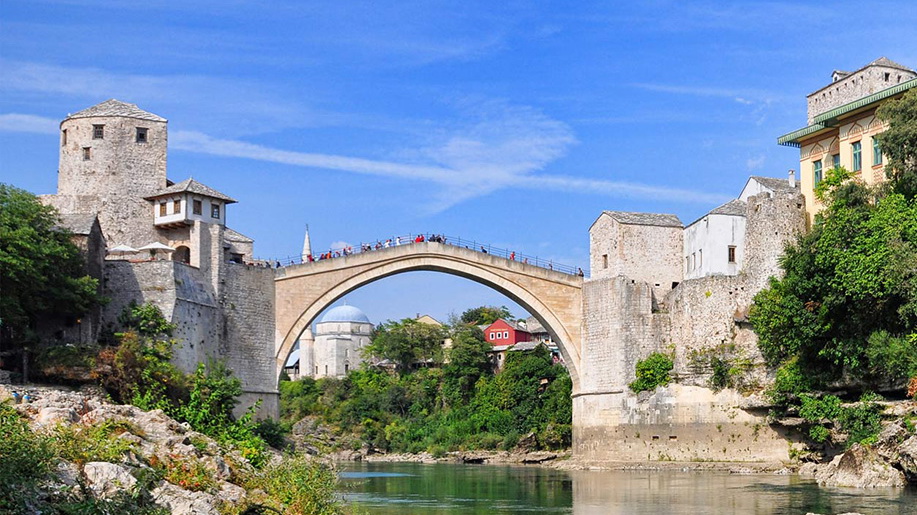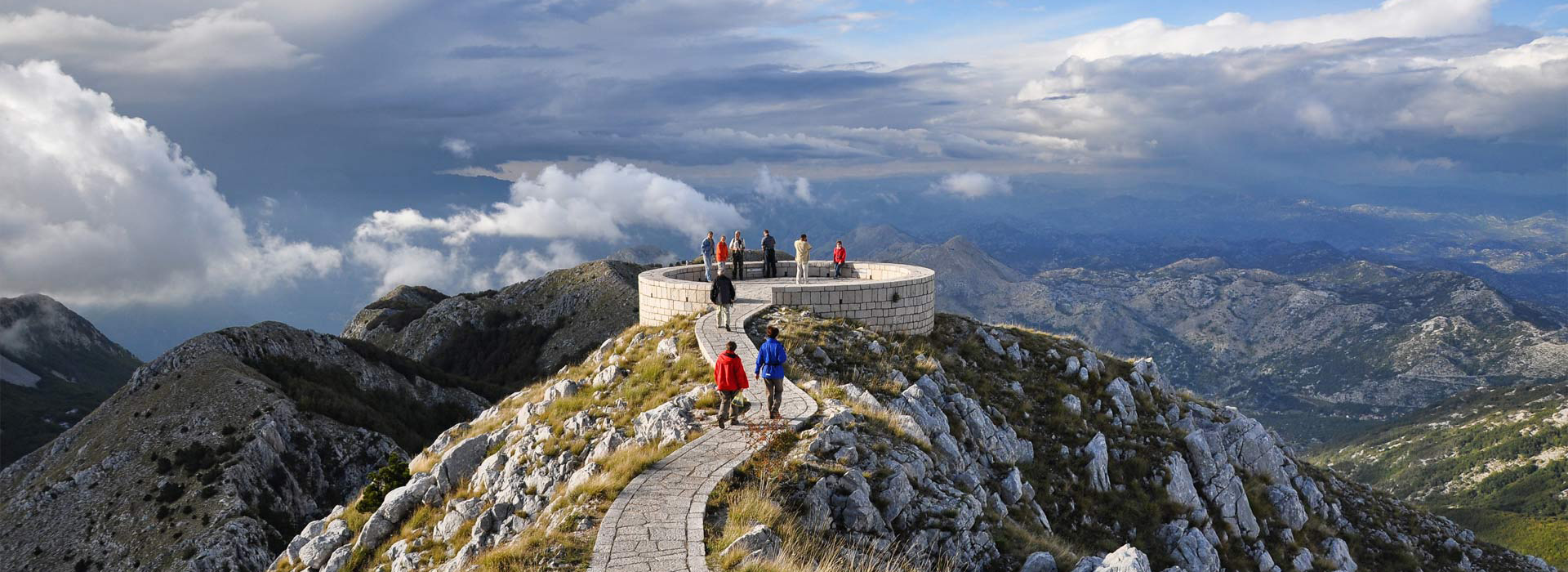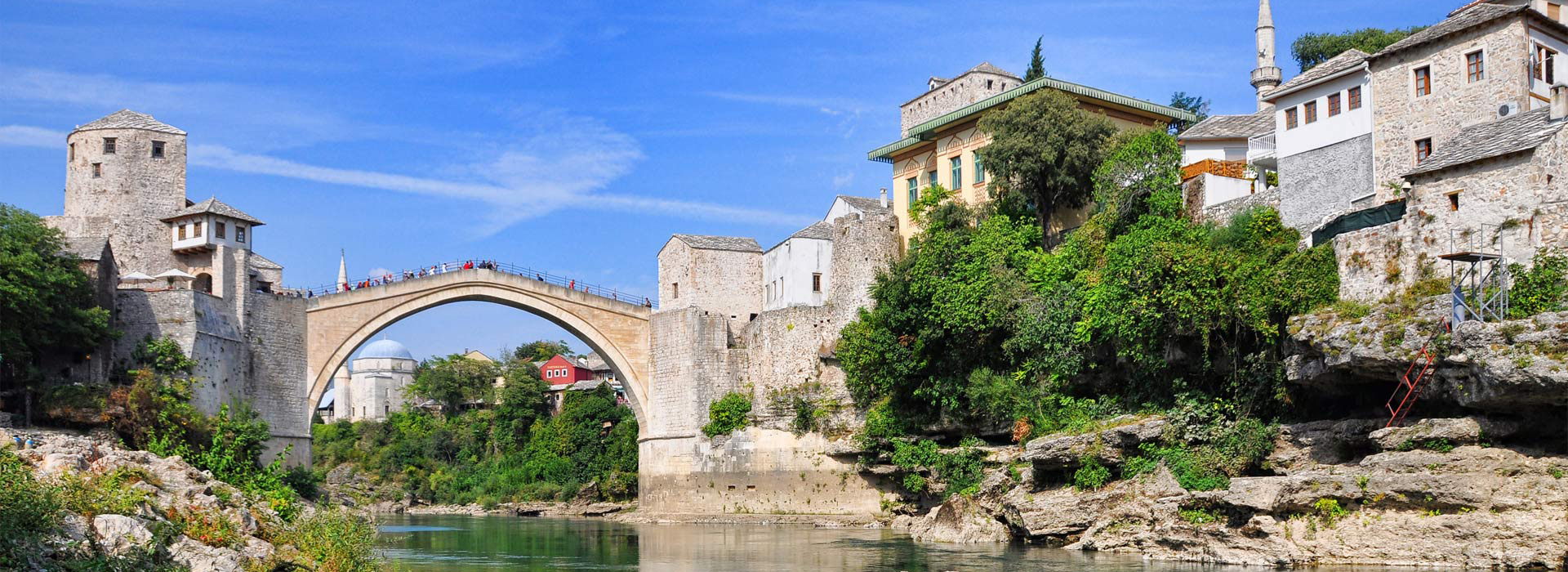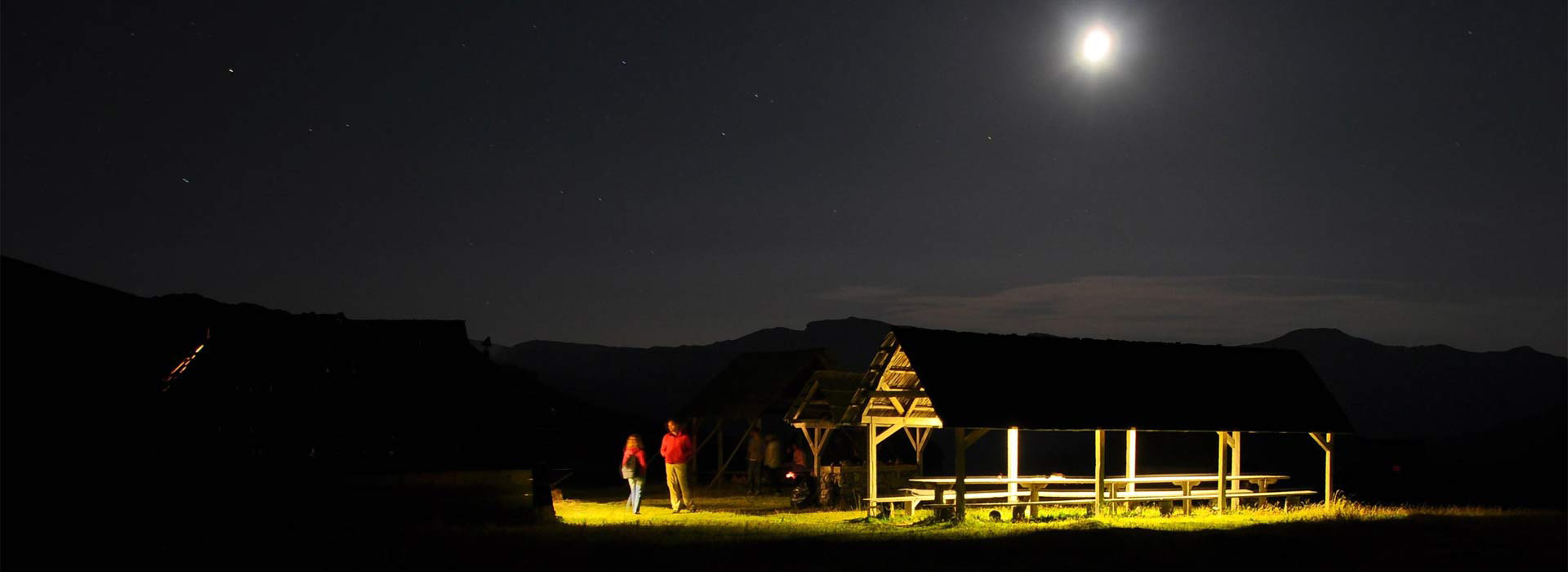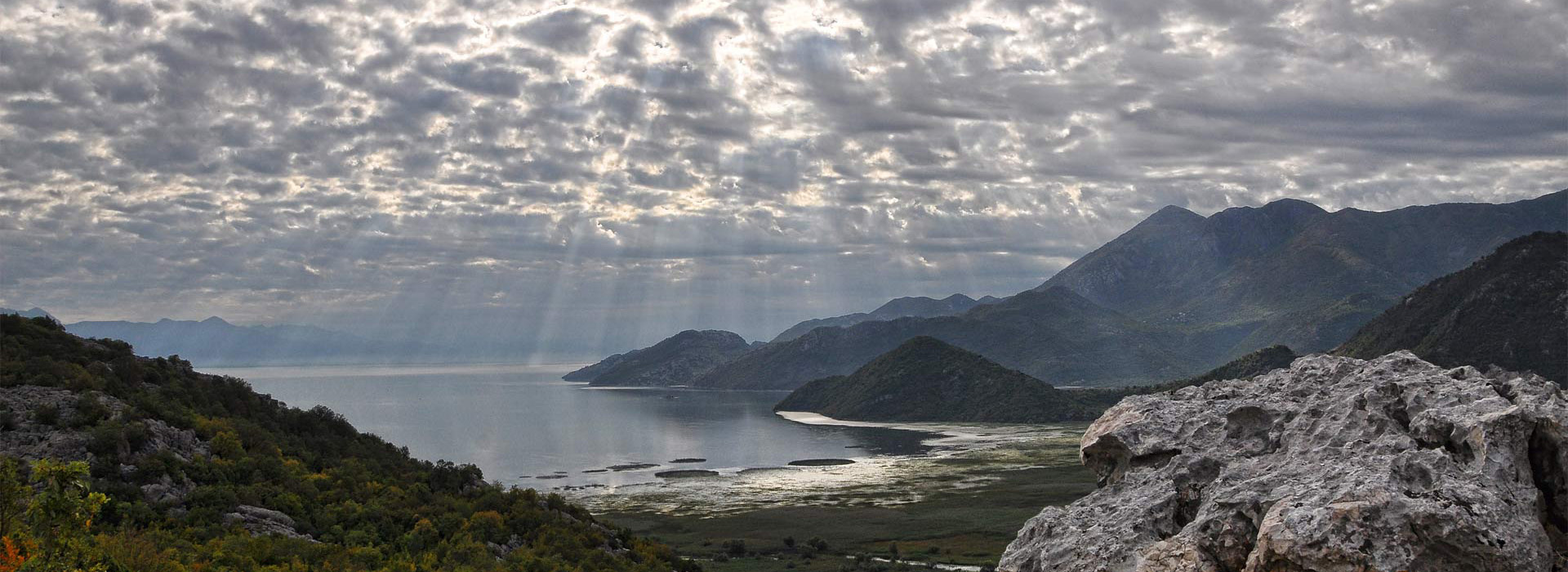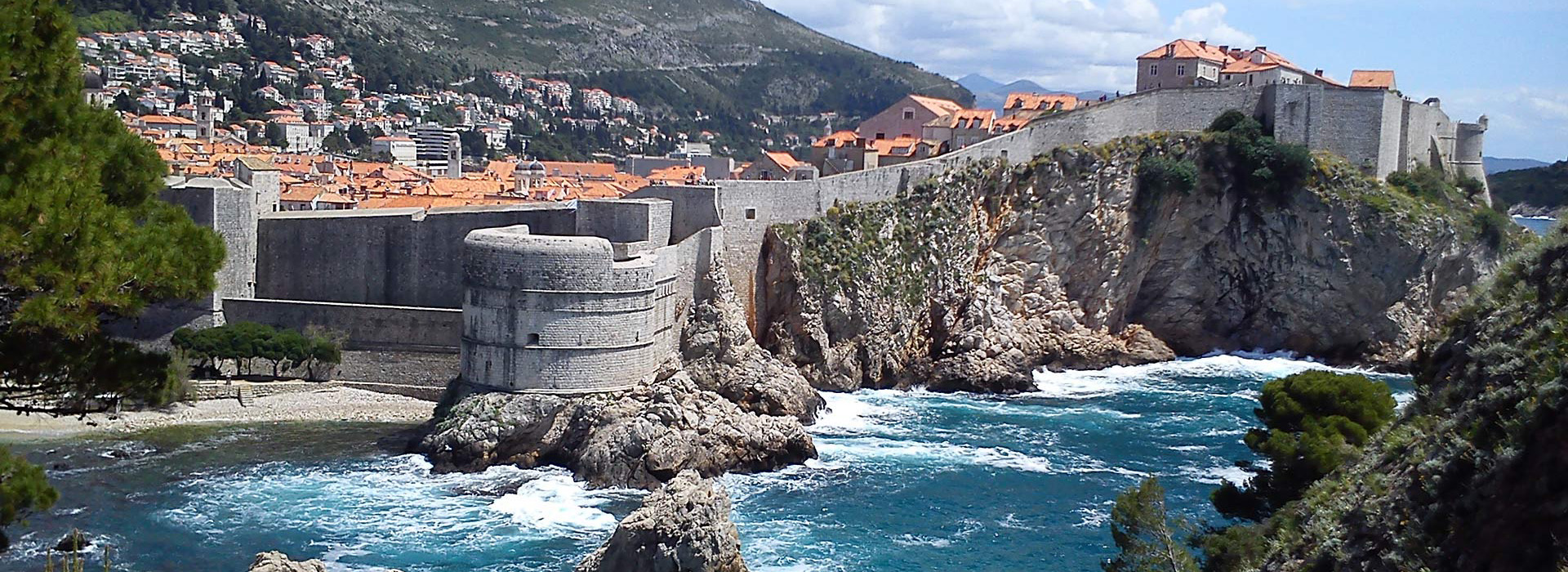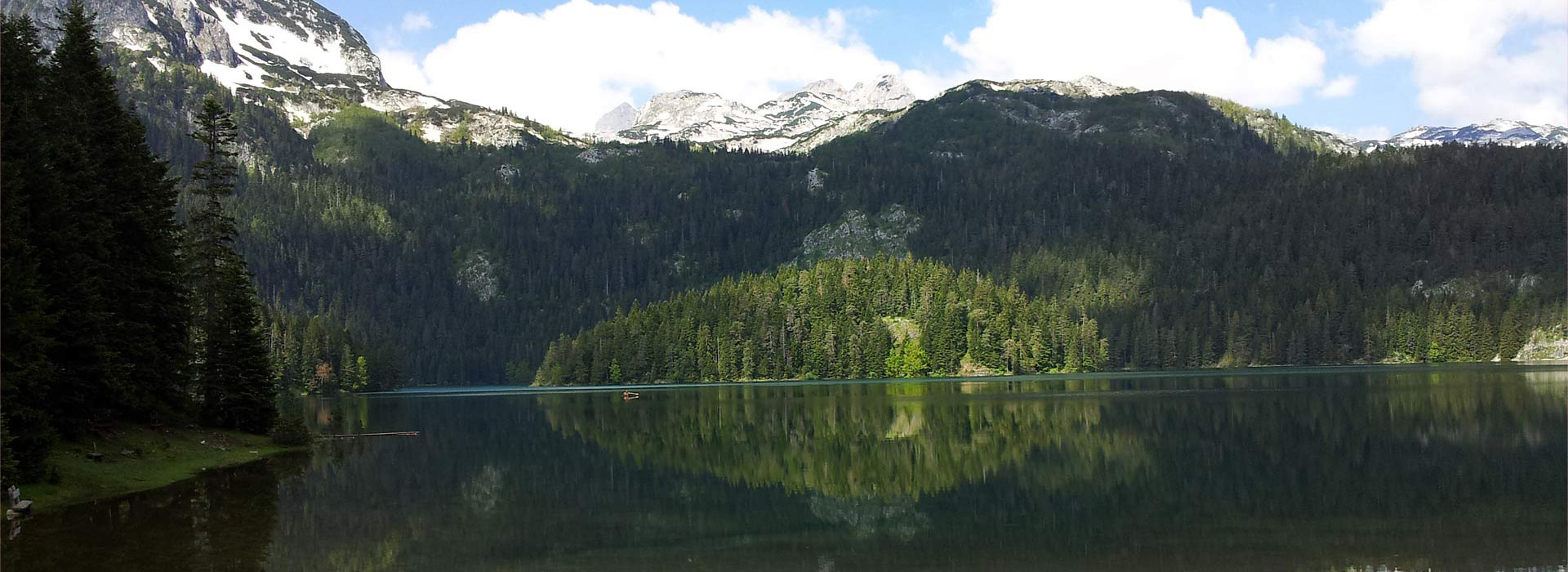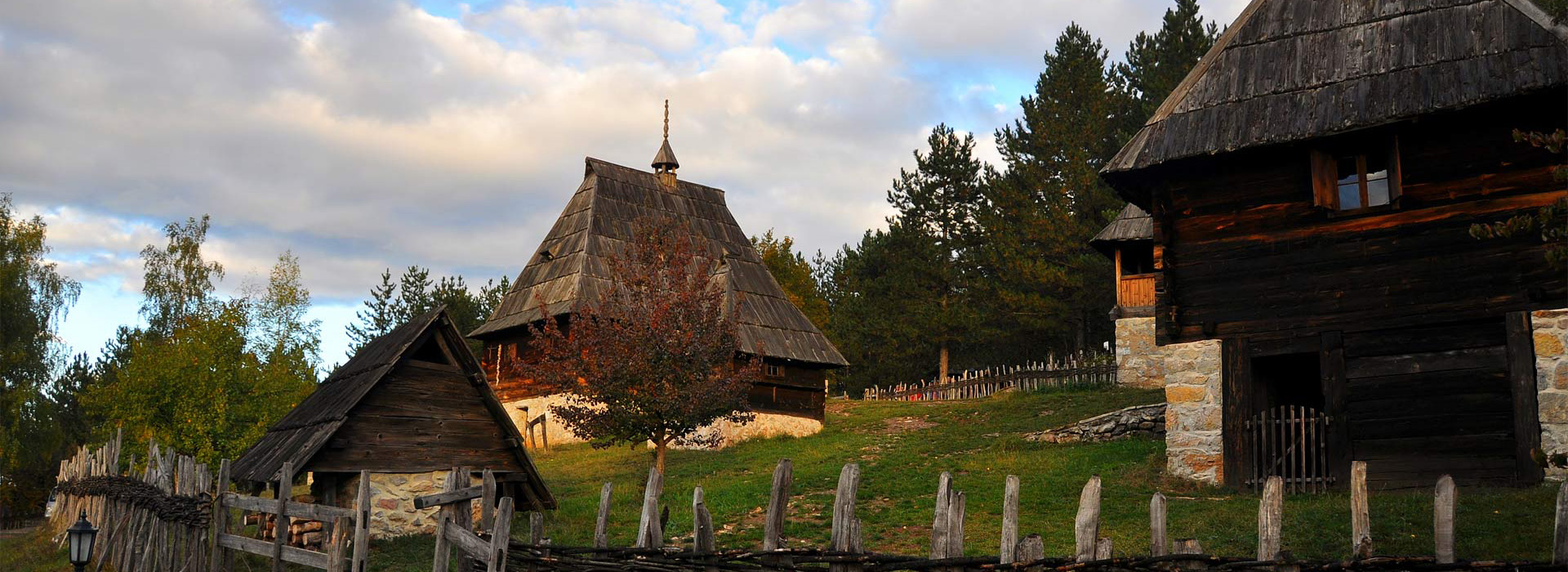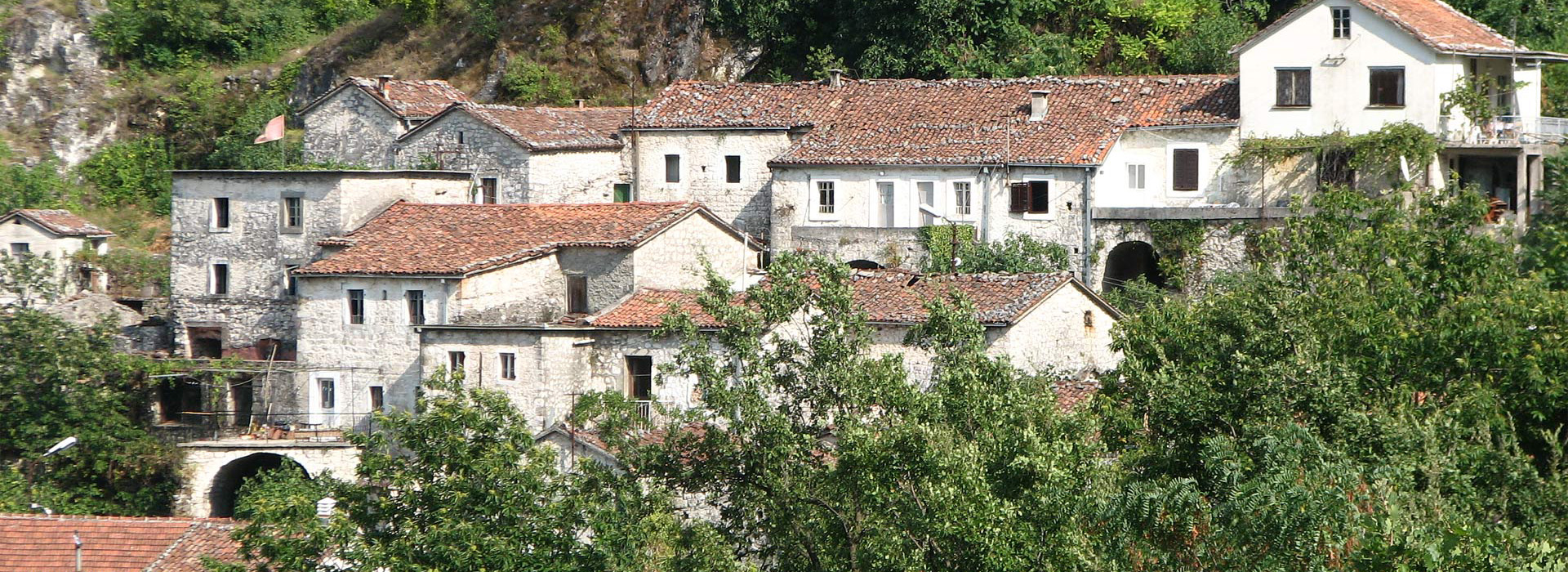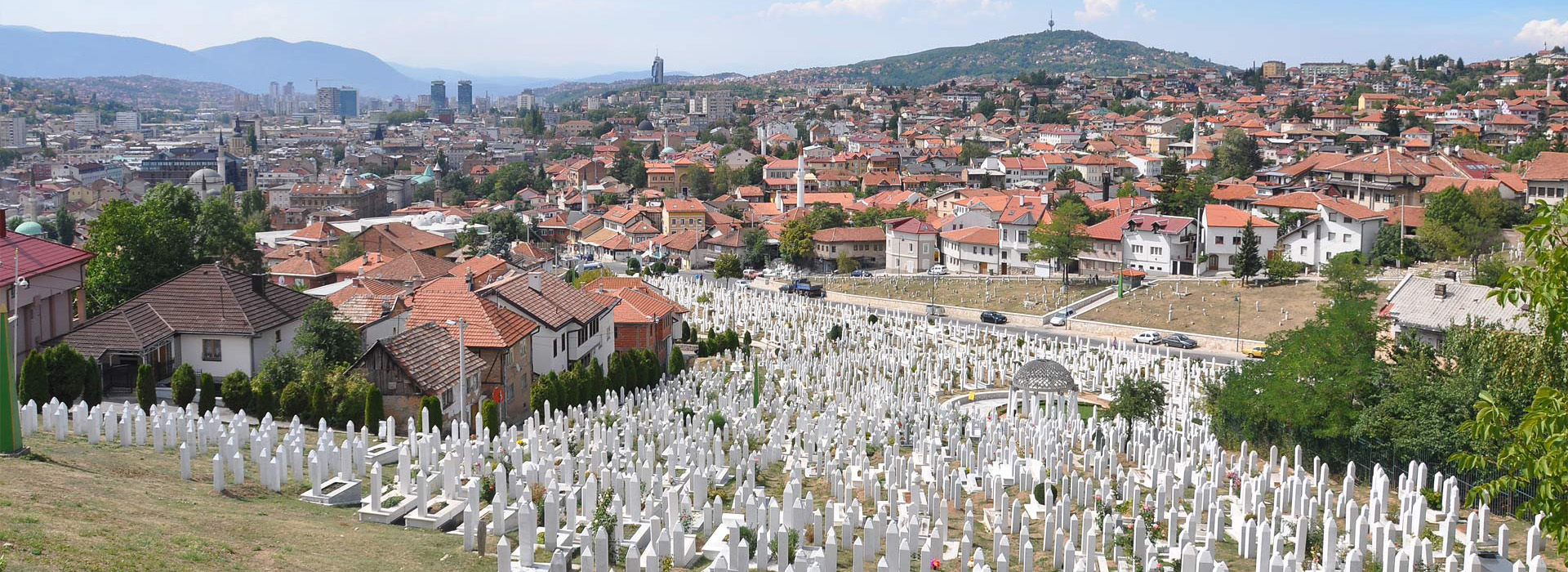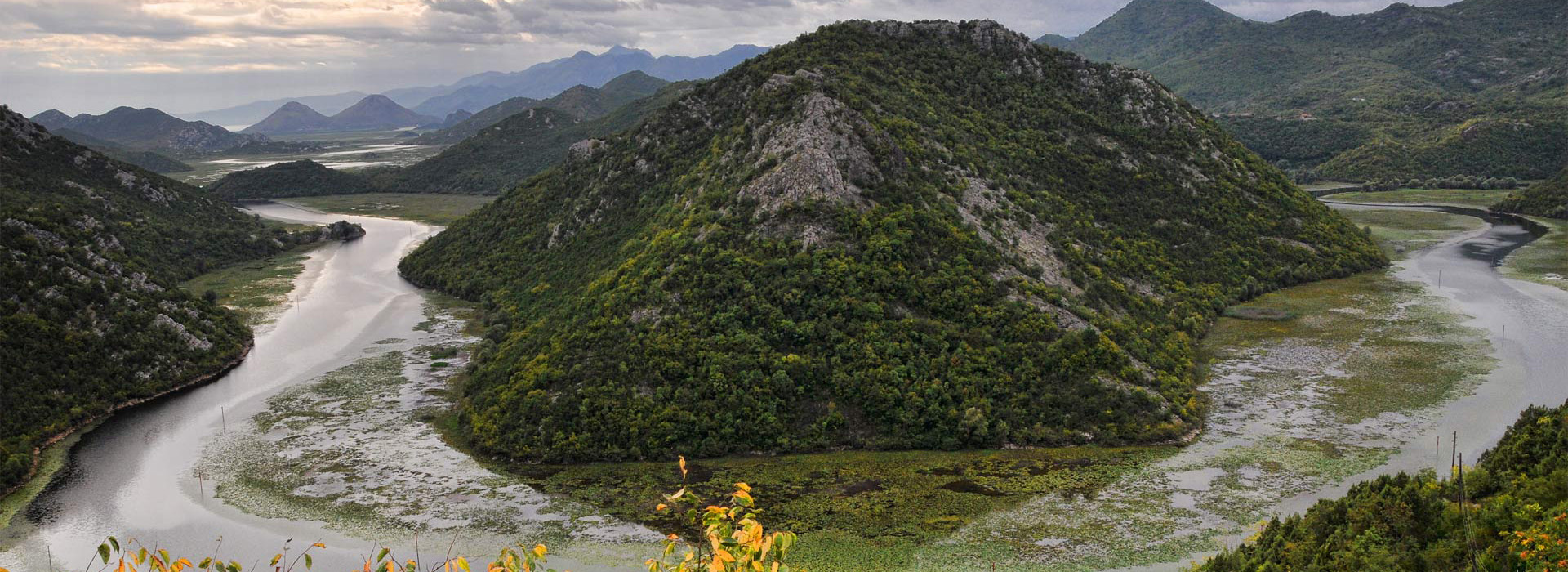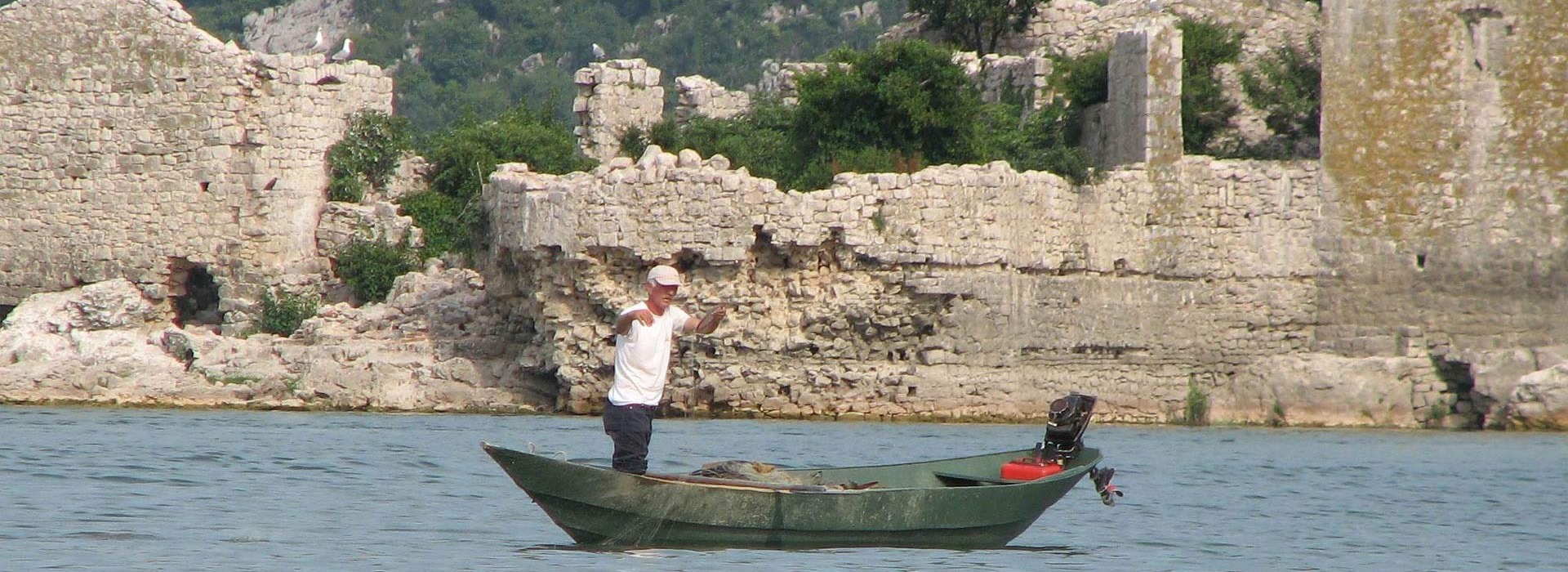
The Balkan’s Cocktail
Walking and cultural discovery trip, exploring Montenegro, Serbia, Bosnia & Herzegovina, and Croatia, their cultural diversities and similarities, spiced with a gourmand Balkan cuisine
15 days / 14 nights guided trip exploring four fascinating Balkans countries while staying in the hotels of very great comfort- from 2580 EUR
Get to know countries that are constantly modified by the forces of attraction and repulsion. The countries of the Western Balkans, where history and culture unify them at one moment, and at another one, act as a destructive force.
-
This journey explores the heart of former Yugoslavia. In 15 days, we will travel through Montenegro, Serbia, Bosnia and Herzegovina and Croatia and discover their national parks, dramatic coastline and historical cities such as Sarajevo, Mostar, Dubrovnik, Kotor…
-
Our longest-running and the most popular tour, which discretely represents the essential values of all four countries.
-
Take a ride on the largest lake on the Balkan Peninsula - Skadar Lake, one of the most important birds reserve in the Balkans.
-
Walk to the Gate of Wishes, and for a twist, let's spend the night in the traditional shepherd's huts on the mountain Bjelasica under the lights of the stars.
-
Visit the Mileseva Monastery and see the most famous fresco of Serbian culture - the White Angel.
-
Spend the night in the open-air museum - Sirogojno, and experience rural life in Serbian villages.
-
Stay in Kustendorf - Hotel-village of one of the most famous film directors from this area.
-
In Bosnia - cross over The Bridge on the Drina River(Na Drini Ćuprija). The bridge is a silent witness to the events described in the same name novel, written by Ivo Andrić, and awarded by the Nobel Prize in Literature in 1961.
-
Enjoy the wine made by the monks of the Tvrdoš monastery, in the karsts of Herzegovina.
-
Relax in peace and the peculiarities of the most beautiful bay of Adriatic - the Bay of Kotor.
-
Climb Lovćen mountain and visit the mausoleum of the most respected and most famous ruler of Montenegro - Prince and Bishop Peter II Petrović Njegoš (1813. - 1851.)
-
You will meet hospitality and local culture accompanied by an A.C.E. tour leader and driver. Their knowledge and love for these parts of their homeland will clarify many truths and misconceptions about the Western Balkans in the best way. .

Travelling through the heart of former Yugoslavia
BLOG STORY
Read more on ACE Adventure blog
The Balkans Unveiled: A Travel Chronicle
The Balkans Cocktail Walking Tour - a journey that truly encapsulates the essence of the Balkans
Walking grade:
Easy
Nine days of gentle walks. Five days of daily hikes about 3 hours with the accumulated ascent up to 300 meters
RECOMMENDATIONS FOR EXTENSION
An option to extend your holiday for additional days on the Adriatic coast is possible. Please contact us for the suggestions and conditions of this extension.
Book with confidence and risk-free. Please read our new booking and cancellation policy
Please read and respect ACE Responsible Tourism Policy.
Itinerary
-
-
Welcome!
A short drive from Podgorica airport to the hotel in Podgorica. After check-in, you will have the opportunity to meet the tour leader and the group. After an introductory briefing, you have free time to explore the capital of Montenegro at your own pace. -
Meals Included: /
Activity Free time on arrival at accomodation.
-
-
-
Only 30 km from the capital of Montenegro - Podgorica, is the largest lake in southern Europe. It is fed by the river Morača with its tributaries. On its way to the Adriatic Sea, the crystal-clear mountain river encountered an obstacle in the form of a mountain massif, and looking for a way out, created this lake.
From the town of Virpazar, which seems to have been created for a theatrical play (it is quite small but at the same time extremely colourful and interesting), we take a boat trip to explore the lake. We navigate through the reeds and meadows of water lilies. And when we get out of this tucked belt, we will have a view of a large natural mirror that reflects the mountains, fishing villages, monasteries and churches, a former island with the fortress Lesandro from the Ottoman Empire, a current island with a former prison - Grmožur. Skadar Lake is also a very important point for migratory birds.
We set aside the second part of the day for a tour of Godinje - village above the lake on the slopes of Mount Rumija. This small village, at the time of the expansion of the Ottoman Empire, was often the site of battles between Turks and Montenegrins. The inhabitants of the village, therefore, built at that time a series of underground passages that connected all the houses in the village and led out of the village. Today, it stands out with local specialities and wine production, because this region, where the humid sea breeze and sharp mountain air meet, is especially suitable for growing quality wine. There, we will have a chance to taste some of the local wines and have lunch. -
Meals Included: Breakfast, Lunch
Activity Boat trip 2h30, walk 45min, ascent +110m / descent – 110m.
-
-
-
We leave Podgorica and move deeper into Montenegro. After a short drive, with a carefree chat, walking along the icy clear river Mrtvica, we can't escape the impression that we are headed to some magical place, through some enchanted kingdom. In the end, we reach a really magical place - the Gate of Wishes (Kapija Želja). It seems here that the two rocks merged into a kiss of love. This place fulfils wishes. You need to strongly make a wish, and throw a pebble through the gate into the emerald green water. Just be careful: the wish must not be to the detriment of the other, because otherwise, it will return by misfortune.
And then, we move from the magical to the ecclesiastical. At our next stop, we will get to know the Orthodox faith in the best way. Let Morača Monastery tell you about Orthodoxy! It was built in a gorge above the Morača river, which, as a guardian of time, guards over this area.
May this day please and inspire even the greatest connoisseurs of spirituality. Let’s finish it, then, in the same style. We will replace, the comfort of hotel room, with a luxurious scenery of the starry sky. Tonight, we will allow the great creative mother of nature to lull us to sleep, in somewhat more modest beds, with stories about the beauty of creation. -
Meals Included: Breakfast, Lunch, Dinner
Activity Hiking 3h, ascent 240m / descent 240m
-
-
-
Today, on the way to Žabljak, we will stop at the impressive Đurđević Tara bridge, which connects the two sides of the Tara river canyon. As we walk across the bridge, from a height of 135m, we will enjoy the view of the Tara River and the vertical cliffs overgrown with tall and proud pines, which, with their endurance and perseverance, defying all adversity and harsh conditions, deserve the greatest laurels.
Žabljak is a sleepy town, but nowadays, especially in summer, there are many hikers and other nature lovers.
It takes time to truly know someone. But if we look someone in the eyes when meeting, it could be enough in getting to know him or her. It doesn’t take long, and we’ve built the foundations to hang out in the future. That's why we're going to meet the eyes of the Durmitor mountain- the Black, Snake and Pond Lakes (Crno, Zminje and Barno Jezero). People of the Balkans call glacial lakes the Mountain Eyes. We will follow paths bordered by dense forests of pines and spruce trees. We will be accompanied by the rocky peaks of Durmitor the whole time. And that accompaniment will delight us even more. -
Meals Included: Breakfast, Dinner
Activity Hiking 3h10, ascent +110m / descent – 110m, gently rolling terrain.
-
-
-
Northeast of Žabljak is Serbia. We head there today. We will first stop at another precious cultural and religious place. The Mileseva Monastery, which, in addition to peace within its walls, preserves one of the greatest treasures of the Orthodox world, the Fresco of the White Angel. The electronic image of which was sent into space in 1963 as the only work of art deemed relevant as a description of humanity sent by the people of Earth. This incredibly powerful work of art, with its peaceful androgenic image of an angel, radiates and calls for peace and tolerance among nations.
And with peace in our hearts, we reach Sirogojno village on Zlatibor Mountain, more precisely the Old Village (Staro Selo) - an open-air museum. Abandoned and restored original 19th-century houses from villages and hamlets from the Zlatibor Mountains were brought to this hill, partially overgrown with pine forest.
Here we will have the opportunity to get acquainted with the past of Serbian villages, the everyday life of the villagers, and enjoy the traditional gourmet cuisine, for which the Zlatibor region is far known in Serbia. -
Meals Included: Breakfast, Dinner
Activity Sightseeing, transfer, border crossing
-
-
-
Driving on the section Mokra Gora - Vilusi, with a total length of fifteen and a half kilometres, passing through twenty-two tunnels and stopping at several passing stations, you will understand what train travel used to look like before. This section is only a part of the railway that used to connect Dubrovnik and Belgrade over Sarajevo. The track overcomes a large height difference and makes a large number of serpentines. Therefore, when viewed from the air, the rail tracks form the shape of the digit eight.
At the Hotel-Village Kustendorff you will enjoy romantic scenery in vivid colours. You can easily imagine yourself as an actor playing the role of a traveller. Your role: enjoy carefree local cafes, restaurants, swimming pools and saunas, basketball and tennis courts, or a stroll through the countryside in the early evening. -
Meals Included: Breakfast, Dinner
Activity Ride a historic narrow gauge train, 2h10
-
-
-
And as soon as we enter Bosnia and Herzegovina, here we are in Višegrad, right on the Bridge over the Drina. Apart from the fact that Ivo Andrić, our famous writer, immortalized the name of this bridge in the novel of the same name, this stone bridge with its eleven magnificent arches is a true masterpiece of Ottoman architecture.
If you are in the mood for a little more walking, there is another Hotel-village of the Famous Artist Kusturica - Stone-town (Kamengrad). Built-in the style of Herzegovinian towns and with the charm of Dalmatia, with its stone houses, streets, and squares, it speaks of the spirit of an artist who wants to connect, to create, and not to dismantle.
Sarajevo - The vibrant capital of Bosnia and Herzegovina, a city where Orthodoxy, Islam, and Catholicism meet. In the time of Yugoslavia, it was considered the heart of the country. Not only because of its central position but more because of the harmony and love of the people of all religions who lived in it. It was considered a place of music, parties, fun ... and then the war. Like a big pendulum of a clock that swings from one end to another- our Sarajevo is thrown into the greatest horror of war, it becomes a place of greatest suffering and fiercest fighting.
But a lot of years have passed since then, and the pendulum has swung back from that ugly end. Now, without any discomfort, you can once again enjoy its streets. -
Meals Included: Breakfast, Dinner
Activity Sightseeing, transfer, border crossing, Free time in Sarajevo.
-
-
-
TThe streets of Baščaršija (old part of town) are full of shops... images and sounds of the eastern Bazaars. Shops where copper pots, trays, and other metal cutlery and dishes are made. Barbershops, wooden objects, tools, burek, earrings and jewellery, kebabs... streets full of people ... mosques ... and again shops with fabrics and tailoring materials, scarves, knife sharpeners, watches, mobile phones, cups and pots ... the low roofs of the workshops covered with red tiles, all make a maze of the old eastern bazaar. The main square of this part of the city - Sebilj is always full of pigeons and the people who feed them. In the middle of the square is a wooden fountain covered with a copper dome, which many consider a symbol of Baščaršija. It dates back to 1891 and represents a reconstruction of the fountain erected in 1754 and destroyed in a fire in 1852.
A walk-through Sarajevo is a walk through the history and cultures of various conquerors who temporarily governed this city. Thus, from the part of the city that is unmistakably the legacy of the Ottoman Empire, we move without noticeable borders to the part where the Austro-Hungarian Empire left its mark. There, everything is more similar to other cities of European culture: the Catholic Cathedral, the Orthodox Cathedral and walk through the wide pedestrian zones. A visit to the brewery, where Sarajevsko Beer is brewed, is also not a bad idea. Or you can walk along the quay of the river Miljatska, buy some delicious ice cream, or have the famous "dest upola s lukom" - Sarajevo's street food speciality – minced beef, finger-shaped, in half a bun with onions.
There is something else you must not miss - the place where Gavrilo Princip, a member of the Young Bosnia movement that fought to overthrow the Austro-Hungarian government and join Yugoslavia, assassinated the Austro-Hungarian Prince Ferdinand. The event triggered the beginning of the First World War. -
Meals Included: Breakfast
Activity Walking City Tour 2h
-
-
-
Halfway to Mostar, in the small Bosnian town of Konjic, we will stop to taste another delicacy. From Konjic, we take a road that it seems to leads nowhere. But the road will take us to a hidden bunker built in the 1950s to be the Atomic War Command in the event of a nuclear war. From there, the Marchal Tito and his 350 closest comrades would command and lead the country. After the break-up of Yugoslavia, it remained a secret to all but a few people familiar with its position and construction. Quite by accident, during the renovation works of one of the exterior-mask buildings, construction workers found a tunnel that led to the heart of the hill. This story ends in the most beautiful possible way and is the right formula for how the world should function. Namely, such a dark building, created in case of mass extermination, has been transformed into a building of a prestigious cultural institution where you will see installations and works of local, regional, and European artists. Works that critically look at the past, but also at the present, sending a clear message to humanity in which direction to go.
Mostar - a city on two rocky banks of the Neretva River, squeezed by the Herzegovinian steep mountains, connected by a slender fairy arch of a stone bridge. Due to its unique beauty and elegance, perfectly blended into the stone landscape and enriches it with a special elegant note. This bridge is the most recognizable landmark of Bosnia and Herzegovina. From this bridge, brave local young men jump from a height of twenty-four meters into the emerald-turquoise clear water of the Neretva River. In the architecture of the old town, its narrow-cobbled streets, stone houses covered with stone shingles, we feel that we are slowly approaching the coast. -
Meals Included: Breakfast
Activity Tito's nuclear bunker tour 1h, Mostar city Tour 1h
-
-
-
Understanding the administrative and ethnological division of Bosnia and Herzegovina, or more recently, the division into two entities: The Federation of Bosnia and Herzegovina and The Republika Srpska, is a very complicated task. Let's just say that Mostar is the largest city in Herzegovina in the entity of the Federation and that Trebinje is the largest city in Herzegovina in the entity of Republika Srpska. Note: do not confuse Republika Srpska with the Republic of Serbia. The Republika Srpska is an entity within the Republic of Bosnia and Herzegovina, and the Republic of Serbia is an independent country bordering Bosnia and Herzegovina.
Now that we have clarified everything, we can move on.
On the foundations of the church from the fourth century, which can still be seen under the glass floor, delicious wine and other products of the divine beverages will be offered to us by the monks of Monastery Tvrdoš. Tvrdoš monastery is only four kilometres from Trebinje town and dates back to the fifteenth century.
Trebinje is a town surrounded by stone walls on the banks of the river Trebišnica. What especially distinguishes it, apart from the charm and beauty of such stone towns, is the proximity to the biggest tourist pearl - Dubrovnik. Only twenty kilometres from the border with Croatia, and 30 kilometres from Dubrovnik, lies Trebinje- the town in Herzegovina and offers a pleasant peace and shade of plane trees as a contrast to the Dubrovnik crowd. -
Meals Included: Breakfast
Activity Sightseeing, wine tasting
-
-
-
Dubrovnik - certainly one of the most beautiful, and allow me not be too humble, the most beautiful fortified medieval town in the world! With its rich history, connections with the Venetian Republic, it is certainly one of the pearls on our journey. It is a place that not only highlighted the natural beauty of the southernmost Croatian coastline, but it seems that nature brought together human creativity and natural beauty to create a work that will inspire everyone.
-
Meals Included: Breakfast
Activity Sightseeing, Dubrovnik city Tour 2h30
-
-
-
Curving the beautiful and picturesque Adriatic road, we will re-enter Montenegro and start closing our loop itinerary. Following the road framed by cypress trees, with sounds of crickets which subjectively raise the temperature and invite us to the shade, constantly splashed with the scents of the Mediterranean, we reach Herceg Novi. Herceg Novi differs from the neighbouring Perast and Kotor. Whilst these two towns were much more influenced by the Venetian Republic and Catholicism, Herceg Novi was in earlier times under Turkish occupation and later by significant Montenegrin-Orthodox influence. The town is beautiful and it is worth visiting. It is located at the western end of the Kotor bay, guarding the entire bay as a robust and proud guard. Moving east, we come to the narrowest part of the bay, the so-called Chains. It is named after the fact that in the time of pirates and foreign invaders, local defenders used to strung chains from coast to coast and thus prevented invaders from entering the bay. Deeper in the Gulf, Perast awaits us, a town with an incredible history, myths, and barely a few more houses than churches within it. It is located on the steep slopes of Mount Orjen from one side, and the sea on the other side. We will settle in the most beautiful place with a view of the iconic islands of St. George and Our Lady of the Rocks (Gospa od Škrpjela).
-
Meals Included: Breakfast, Dinner
Activity Sightseeing, transfer, Free time.
-
-
-
Every time I come to Kotor I have that warm feeling of safety... somehow, I feel tucked away and protected. I have the impression that I have entered a familiar room where only beautiful things happen, a port where the sea is always calm…
We will climb to St. Ivan's Fortress, which is the easternmost and highest point of the defensive walls that stretch around the entire city, up to 300 metres above sea level. The smell of sage and yarrow will accompany us as we walk. The view on the red roofs of the city made of stone will follow us all the way, as well as the streets that meander, move towards each other, and flow into the squares. The sea and the boats, seagulls in constant search for food, cypresses, and pomegranate bushes... All those impressions seem to bounce off the steep slopes of the surrounding mountains, sinking into the heart again and again. If this doesn't make you romantic - nothing in the world will.
In the afternoon relax with a coffee, a cold beer or a drink in a local cafe bar. Grab lunch and stroll the streets of this beautiful town, visit a museum, maybe a green market, or just imagine that you are a resident and try to feel everyday life. -
Meals Included: Breakfast
Activity Hiking 2,5 h, ascent +300m / descent – 300m, sightseeing
-
-
-
"Who on the mountain height doth take his stand,
Sees more than he who stays upon the plain."
Original:
“Ko na brdu ak´ imalo stoji,
Više vidi no onaj pod brdom.”
Gorski Vijenac (The Mountain Wreath)
1847, Petar II Petrović Njegoš (1813 – 1851) - Prince-Bishop of Montenegro and poet
We drive high into the mountains along the serpentine road above Kotor. The road leads us to the village of Njeguši, widely known for its dried and smoked meat products (Njeguški Prosciutto) and cheeses. Each of the households in this tiny village is engaged in this business as a family. It is worth trying and maybe even buying some of these products.
After a sweet break - a little activity is needed. We will achieve this by hiking from Međuvršje to Njegoš's Mausoleum, which is located at the “Jezerski” summit. The trail is mostly wooded. The last leg is a stair consisting of 461 steps to the Mausoleum where the greatest son of Montenegro rests - Prince-Bishop Petar II Petrović Njegoš. Lived from 1813 to 1851 and ruled from 1830 to 1851, this philosopher, poet, bishop, and prince was and remains the most respected figure in Montenegrin history among all Montenegrins. The mausoleum is the work of the famous Croatian sculptor Ivan Meštrović and was erected in 1974. The relics were transferred from a modest church on the same site, which was destroyed during the construction of the mausoleum.
With a strong impression of omnipresence over the whole of Montenegro, both physically and spiritually, we walk down to Ivan's Troughs, where we can drink clean and cold spring water. From here we will drive back to our hotel in Perast for the last group supper on this journey. -
Meals Included: Breakfast, Dinner
Activity Prosciutto and cheese tasting, Hiking 3,5h, ascent +350m / descent -450m.
-
-
-
This slow Balkan adventure ends today. After breakfast, we drive you to Podgorica airport and wish you a safe and pleasant journey, with the desire to see you again on another adventure, on another tour ...
-
Meals Included: Breakfast
Activity Transfer
-
Tour Information
-
Skadar Lake
With the area ranging from 370 to 530 square kilometers, Skadar Lake is the biggest lake in the Balkans. Due to its geographic position and sub Mediterranean climate, it is one of the most important habitats of swamp birds in Europe, right after the river Danube delta. There are around 280 bird species on the lake, including the rare curly pelican, which became a trademark of the National Park. Southern hinterland of the lake (Crmnica) is famous for the best vine in Montenegro. Together with the lake carp, this will satisfy even the most demanding gourmands. The lake has numerous extraordinary beaches, particularly those in the village Murići, not less attractive than beaches on the coast…
Bjelasica
The mountain of Bjelasica is characterized by three important characteristics and comparative advantages: very easy mobility and accessibility to the highest mountain peaks, the great wealth of forests and abundance of running water. Unlike other mountains in the region, Bjelasica is of volcanic origin. Hence, green summer and winter white. While the water of Durmitor or Lovćen fail, everything stays here on the surface, flows into numerous streams and rivers, of which perhaps the most important and most beautiful is the Biograd River, which flows into the pearl of the mountain called the Biograd Lake. An original primeval forest of broadleaf and conifers is preserved in the Biogradska Gora National Park.
DURMITOR
DURMITOR is inscribed on the World Heritage List in 1980. It is a strikingly beautiful natural park, one of the highest (2523 m) and probably the most beautiful mountain on the Balkans. There are 17 glacier lakes called “mountain eyes” in the area of Durmitor. The most famous is Black Lake, covered with ice and crystals of frozen snowflakes in the winter. You can swim in it in the middle of the summer. Between the steep hillsides or hidden in the green, thick foliage, are the magic beauties: Zmijinje, Barno, Riblje, Vrazje, Modro and the other lakes. Because of its geographical location and range in altitude, the park is under the influence of both Mediterranean and alpine micro climates. Vegetation zones, covering 17,000ha, include deciduous forest, coniferous forest, sub-alpine zones and Alpine meadows. The dominant species include Scots pine, Norway pine, silver fir, beech, occasional birch, mugo pine and juniper. The park supports a rich korstic flora with many rare and endemic species.
Zabljak town is “moved up” to 1460 meters of the massive mountain of Durmitor. This small mountain town will be used as our base for exploring the mountain. Our hiking tours will start from the hotel.The monastery of MILESEVA
The monastery of MILESEVA was founded by Vladislav, King of Serbia, son of Stefan the First-Crowned and grandson of Stefan Nemanja, founder of the Serbian medieval dynasty. Nowadays Mileseva is mainly known for its frescoes. These frescoes are reckoned by many experts among the most beautiful achievements not only of the Serbian, but even of the European painting in the Middle Ages. The greatest artistic value is ascribed to those frescoes of Mileseva, which are the portraits of the first kings of the Nemanjic dynasty. Today, the renown of Mileseva has been mostly spread out by the figure of the Angel on Christ’s tomb, which by the skillfulness of drawing, harmony of colors and spirituality of expression emanates with nearly a transcendent beauty.
ZLATIBOR
ZLATIBOR MOUNTAIN is one of the most beautiful and friendly mountainous regions in Serbia. The specific climate and harmonious relationship among dense evergreen forests and spacious meadows covered with colorful flowers, streams, unpolluted air, clear water, has developed this mountain into a famous summer and winter resort with the longest tourist tradition in Serbia.The average height of Zlatibor is about 1.000 m above sea level. Zlatibor is rich in excellent drinking waters. The traditional art of buildings in this region is exceptionally characteristic. The Zlatibor log cabin represents the most accomplished form of traditional Serbian housing within the Dinaric Mountain Range. The old buildings that have survived were fashioned with great craftsmanship and illustrate the skill and art achieved by our people in constructing houses to suit their needs and their sense of beauty.
SIROGOJNO
The open air “Old Village” (“Staro selo”) Museum at SIROGOJNO represents the village dwelling culture on Zlatibor Mountain. To save at least a part of this cultural heritage a number of authentic objects and buildings have been transferred to the present site of the Museum and conserved in order to be used for further research and to be exhibited for the public.
The Museum has a particularly elaborate program to revive old local arts and crafts. Copies of objects of fine workmanship are produced in the workshop of the Museum: pottery, hand printed textiles, utensils of wood and iron.Sarganska Osmica
Sarganska Osmica Rail is section of the railway that connects Western Serbia and Eastern Bosnia and West Morava and Drina Valleys. It was built in 1925. In 13.5 kilometers from Sargan to Mokra Gora station the railway climbs the altitude difference of 450 meters. The route of the rail is remarkable and has shape of digit “eight”. To pass distance from Sargan to Mokra Gora train goes over 5 bridges and 20 tunnels. The railway track is narrow- only 0.76 meters.
In 1974. the railway traffic was suspended. After reconstruction works in 1999 trains started to operate again but this time as tourist attractionAfter ride in a small “Cira” train we will visit Emir Kusturica movie village- Kustendorf, where his film “Zivot je Cudo”(Life is a Miracle) was shut. Kustendorf is project of a famous film director Emir Kusturica. In marvelous nature setting of western Serbia he built ethno village as a base for his work-shops. Colorful houses, church restaurant and underground cinema will make impression that you are moved to one of his movies. The site is now open for tourist.The Bridge of Višegrad
The Bridge of Višegrad across the Drina River in the east of Bosnia and Herzegovina was built at the end of the 16th century by the court architect Mimar Koca Sinan on the orders of Grand Vizier Mehmed Paša Sokolović. Characteristic of the apogee of Ottoman monumental architecture and civil engineering, the bridge has 11 masonry arches with spans of 11 m to 15 m, and an access ramp at right angles with four arches on the left bank of the river. The 179.5 m long bridge is a representative masterpiece of Sinan, one of the greatest architects and engineers of the classical Ottoman period and a contemporary of the Italian Renaissance, with which his work may be compared. The unique elegance of proportion and monumental nobility of the whole site bear witness to the greatness of this style of architecture.The universal value of the bridge at Višegrad is unquestionable for all the historical reasons and in view of the architectural values it has. It represents a major stage in the history of civil engineering and bridge architecture, erected by one of the most celebrated builders of the Ottoman Empire.
SARAJEVO
“And at whatever time of day, and from whatever corner you set your sights on Sarajevo – you always, and without specific intention, think the same thing: that is a city. A city that both nears its end and is dying, yet simultaneously is being born and growing.” – Ivo Andric
The city of Sarajevo came into existence on the exact place whose center is the crossroads of East and West, of Roman Catholicism and Eastern Orthodoxy, of Christianity and Islam, of Austrian boulevards and Ottoman shops, of modern skyscrapers and European squares.
The transition from East to West is much more than a metaphor; in Sarajevo, it is literal, geographical process. From the Ottoman East with it’s magnificent mosques and Oriental architecture, through the Austrian Center with it’s proud churches and European architecture, to the modern West with it’s towering buildings and wide highways.
In this valley, an amazing alchemy of cultures and religions merges into a single one – yet, each keeps something of its character and is recognizable for what it is. Light from the same source passes through the stained glass windows of the Katedrala, illuminates the gem that is Begova Mosque, lights of the central chandeleir of the Church of the Lord’s Holy Transfiguration, and caresses the ancient Soloman’s Seal, the Star of David. Nevertheless, it is all one whole, which could hardly be modified in any way. Trying to understand Sarajevo is one of the nicer things one can do in this world.Mostar
The city of Mostar is situated in a beautiful valley bedded between high mountains of Herzegovina. It is thanks to the river Neretva that Mostar was able to develop as a city in the desert-like landscape of Herzegovina. Neretva’s size turned Mostar very early in to a trading centre of the region. What makes this city known is it’s famous bridge. The Old Bridge was built by the Ottoman empire in 1565. It was the great architect Mimar Hajrudin who had succeded with the impossible mission to cross the Neretva river with a single span stone bridge.
Mostar got its name after that same Bridge, or more precisely after the bridge keepers. They used to guard the bridge and were called “Mostari”, thereby the city got its name. With its hot summers and mild winters, Mostar is also one of Europe’s sunniest cities.Tvrdos
On the way between Trebinje and Mostar lays an old monastery surrounded by vineyards. The monastery was built on the foundation of an old church, and the 4th-century foundations of the first Roman church on the site are still visible today (inside the curch, below the glassbottom). This shows also how long there is Christian religion in Hercegovina. Tvrdos had been frequently destroyed and reconstructed before. The current building of the monastery was constructed in 1924. Today the monastery is temporarily the seat of the Eparchy of Zahumlje and Herzegovina (other ways the seat is in Mostar). The Tvrdos Monastery is also famous for its long tradition of wine production. Tvrdos, has become the symbol and guarantor for true quality, homemade pure wines. The monastery has two wine cellars. Wine ages in hundred years old oak barrels in an old cellar from the XV century and only ten meters away, next to the bank of the river of Trebišnjica, a new cellar has been build and equipped with the modern technology. Cellars of the Tvrdoš Monastery apply traditions of monastery viticulture and Herzegovian climate, producing wines made of autochthonous and international varieties of grapes in the cellar from the XV century. Žilavka, vranac, chardonnay, cabernet sauvignon and traditional monastery varieties are combined using ancient and modern technologies.
Trebinje
Trebinje’s Old Town has emerged at the beginning of the 18th century on the coast of the Trebisnjica River. Current Old Town – Kastel – has been developed from former centre of trade and craft. In the Old Town, on the foundations of Roman, medieval and Turkish town, an Austrian military camp was built at the end of the 19th and at the beginning of the 20th century. Today it houses the museum of Herzegovina.
DUBROVNIK
George Bernard Shaw was enchanted by DUBROVNIK. For him, it was paradise. Millions of people also take home happy memories from this “jewel of the Adriatic”.
Dubrovnik has a remarkable history. An independent, merchant republic for 700 years (abolished by Napoleon in 1806), it traded with Turkey and India in the East (with a consul in Goa, India) and had trade representatives in Africa (in the Cape Verde Islands). It even had diplomatic relations with the English court in the middle ages. (There is a letter from Elizabeth I on display in the City Museum in Dubrovnik). Its status was such that powerful and rich Venice was envious of this Croatian-Slav city. The old town was completed in the 13th century and remains virtually unchanged to the present day. Tall ramparts surround it and there are only two entrances to the old town which lead to the Stradun, the city’s promenade. One of the greatest pleasures for many visitors is to have a drink in one of the nearby cafes and watch the world go by, whilst they themselves are being watched by the city patron, St. Blaise, or Sveti Vlaho as the locals call him.Herceg Novi
Herceg Novi is a coastal town in Montenegro located at the entrance to the Bay of Kotor and at the foot of Mount Orjen. Herceg Novi was known as Castelnuovo for many centuries. Herceg Novi has had a turbulent past, despite being one of the youngest settlements on the Adriatic. A history of varied occupations has created a blend of diverse and picturesque architectural style in the city.
KOTOR
The old town of KOTOR is one of the best-preserved medieval towns in this part of the Mediterranean. It was succeeded in preserving its original form, so typical of towns between the XII and the XIV century. The asymmetric structure of the narrow streets and squares, combined with the numerous valuable monuments of medieval architecture, contributed to Kotor being placed on UNESCO’s “The world natural and cultural inheritance” list. The cultural inheritance of this town is enriched by the unique architectural styles and the ambient atmosphere. The fortification system of Kotor, which protects it from the sea, is actually a wall 4.5 km long, 20 m high and 15 m wide, and is preserved as one of the world’s historic values.
Lovcen
Directly behind Kotor bay rises Mountain Lovćen, the black mountain that gave Crna Gora (Montenegro) its name; crna/negro means ‘black’, and gora/monte means ‘mountain’ in Montenegrin and Italian respectively.
A relatively small area offers numerous and various forms of relief, emphasized in the central part of the mountain, where most of Lovćen summits rose. Its slopes are rocky, with numerous holes, pits and deep depressions, giving the landscape a distinctive look. View from Lovćen peaks leaves an unrepeatable and unforgettable visual impression.
Most of the sacral objects and interesting ethnographic material in Lovćen is concentrated in the area of Ivanova korita and village Njeguši, famous for fantastic ham and cheese. Climbing up to the mausoleum of the greatest Montenegrin poet, Bishop, and prince Petar Petrović Njegoš (1813. -1851), represents a highlight of the visit to the National Park. The mausoleum is the most important work of the great Croatian sculptor Ivan Meštrović. The chapel is the most impressive part of Njegoš mausoleum. It is nine meters high with the arch covered in mosaic with 200.000 gold-plated tiles. -
On this tour, we stay in carefully selected four-star hotels, but with a few exceptions, where we offer the opportunity to get acquainted with truly unique accommodation. That is on Bjelasica - in Katuns - charming wooden cabins with shared facilities (some cabins are bigger and some are small with a size of tents), in comfortable houses of open-air museum Stari Selo (Old village) on Zlatibor mountain. An exception to the 4-star standard is the hotel in Dubrovnik, which, although with three stars, is of great comfort and very well located. All hotels have restaurants with great choices of local specialities. If you have some dietary restrictions we will be happy to adapt our menu to you. All breakfasts and dinners (except Diner on day 7 - which we will organize in the restaurant in the city of Sarajevo) included in the tour package will be served in the hotels' restaurants. Lunches included in the tour package are either lunch packets or picnic lunches.
-
-
Transfer from Podgorica airport to the hotel. Regardless of your arrival time, a private transfer will be organized for you.
-
14 lodgings
-
14 breakfasts, 2 lunches, 7 dinners
-
The following entry fees and excursions: National Park Skadar Lake entry fee, Boat trip on the Skadar Lake, Wine tasting in Godinje village, entry fee for National Park Durmitor, entry fee for Open Air museum Staro Selo, Sirogojno, ride on historical train Sargan Eight, guided city tours of Sarajevo and Dubrovnik, guided tour of Tito's nuclear bunker, wine tasting in Tvrdos Monastery, Kotor Ramparts entry fee, National Park Lovcen entry fee, prosciutto and cheese tasting in Njegusi village, entry fee for Njegos Mausoleum
-
full guiding service with English, French, or German speaking guide
-
transfer service for all programs listed in tour description
-
Transfer from the hotel in Perast to Podgorica airport. Regardless of your flight time, a private transfer will be organized for you
The following services are included in the price:
The price is based on double room occupancy.
Single room supplement 380 Euros (single room option is not available in Katun on Bjelasica).
The tour is available from April to November
-
-
-
Travel Information
For stay up to 90 days in the Republic of Montenegro, Serbia and Bosnia and Herzegovina tourists from EU, America, Australia, Canada, Japan do not require a visa. Croatia is from 2013 European Union member state. All distances are given in kilometers. 1 mi=1,61 km, 1km =0.62mi, 1ft=0.3m/ 1inch=2.54cm
Weather Information
Weather is difficult to forecast but, normally, you can expect a nice weather from April to November.
Montenegro has a Mediterranean climate, hot dry summers and autumns and relatively cold winters with heavy snowfall inland. There is a chance of sporadic rain in spring and autumn, though generally this is in the form of short showers. You can expect cool nights in the Durmitor Mountain and on higher altitudes it is possible to have light snowing in April, May, October, November.
Serbia has a continental climate. Autumn is often with extended periods of warm , sunny weather. The coldest month of the year is January with average temperature a little bit over 0˚C. Spring is usually very pleasant with daily temperature between 15˚C and 20˚C and occasional rain and showers. The hottest months are July and August with average temperature about 23˚C and daily temperature above 30˚C. The country as a whole receives an average precipitation of between 600mm and 800 mm annually in the plains- about the same as that of southeast England – and about 800mm and 1200mm in highland regions. In July and August we usually have some days with daily max temperature about 35C.
The southern and western parts of oa Bosnia and Herzegovina have Mediterranean climate while inland areas and areas with high elevation experience short, cool summers and long, severe winters. Bosnia-Herzegovina’s climate is different for each province. Herzegovina and the southern area has a modified Mediterranean climate with an average annual precipitation of 600 to 800 mm while the central and northern area of Bosnia has a modified Pannoian or Alpine climate with an average annual precipitation of 1,500 to 2,500 mm. Average temperature ranges in Sarajevo are from -.5 degrees Celsius in January to 19.6 degrees Celsius in July.Packing suggestions
Casual seasonal clothing is recommended for most occasions. You may wish to bring a sweater and some jacket even in summer, comfortable hiking shoes, rain jacket, plus trainers or sandals for relaxing.
You should also bring some water bottles, sun protection cream (high protection factor 30 and above), insect repellent, sunglasses, sun hat, and a lip salve with sun protection. Also bring a swimsuit for swimming opportunities on the trip.General Information
Currency and Exchange
Local Currency: Montenegro use Euro as a local currency. Serbian Dinar (RSD) is monetary unit in Serbia. For 1 Euro you can get 115,00 dinars (current exchange rate). In Bosnia and Herzegovina monetary unit is Bosnia and Herzegovina Marka (BAM). For 1 Euro you can get 1.9 BAM (current exchange rate). Croatia use Kuna (HRK) as a Monetary unit. For 1 Euro you can get 7.3 HRK (current exchange rate).
Where to Exchange: Banks or ‘forex’ offices in main towns/cities. Most of change offices are open from 8am to 8pm
ATM Availability: Generally widespread but limited in more rural areas. You will find ATM in Zabljak, Visegrad, Sarajevo, Mostar, Trebinje, Herceg Novi, Kotor, Cetinje.
Credit Card Acceptance: Accepted in major restaurants and hotels. The most widely excepted credit cards are VISA, closely followed by MasterCard.
Travellers Cheques: Travellers cheques can be exchanged for the local currency but only in some banks.
Banks are generally open from 08:00 to 19:00 on weekdays and from 08:00 to 15:00 on Saturdays.
In smaller towns it is useful to have enough cash.
Most of the shops are open from 9am to 9 pm and remain open through lunch.
Restaurants: The main meal is taken at lunch from 1pm to 3pm. Restaurants serve dinner in the evening from 8pm till 11pm.Electric Current
In all four countries electric current is 220 volts, 50 HZ. To use American or British electrical appliances a plug adapter is necessary. Electric plug used in Montenegro, Serbia, Croatia and B&H is type C (the same one is in use in Belgium, Egypt, Italy, Hungary, Luxemburg, Netherlands, Norway, Bulgaria, Romania, Switzerland, Turkey, Vietnam, etc.)
Telephone
Telephone plug used in Montenegro, Croatia, Serbia, and Bosnia & Herzegovina is US RJ-11 phone plug
Telephoning Home
Most of the telephone cards (AT&T…) do not work here. You can telephone from Post Office and pay after the call. The most convenient way for telephoning home is to use your mobile phone. Note that telephoning from Montenegro, Bosnia and Herzegovina, Croatia and Serbia will involve roaming rates, so please double-check with your mobile provider at home about the rates and conditions.
To make a direct international call, first dial 00 or + (code to access international line) then the country code, the area code and local number. The country code for Austria is 43, Australia is 61, Norway 47, Great Britain is 44, USA and Canada 1, France 33, Germany 49…. To make a national call just dial area code and local telephone number.
ACE Emergency phone (24h available) +381 (0)64 24 76 311.
Important phone numbers in
Serbia: Police 192, Fire department 193, Ambulance 194, Road conditions 1987,
in Bosnia and Herzegovina: 122 for Police, 123 for Fire Department and 124 for Emergency Medical Care, Help on the road 1282/ 1285/ 1288, Emergency number 112
in Montenegro: 122 for Police, 123 for Fire Department and 124 for Emergency Medical Care, Help on the road 19807
in Croatia: 122 for Police, 123 for Fire Department and 124 for Emergency Medical Care, Help on the road 1987Language
In old Yugoslavia Serbo-Croatian, also called Serbo-Croat, Serbo-Croat-Bosnian was a South Slavic language and the primary language of Serbia, Croatia, Bosnia and Herzegovina, and Montenegro. It is a pluricentric language with four mutually intelligible standard varieties. Since the break up of Yugoslavia every new state defined its own language and now Montenegrin is official language in Montenegro, Serbian in Serbia, Bosnian in Bosnia and Herzegovina and Croatian in Croatia. However, all those languages are the same with difference in dialects.
INSURANCE
Travel insurance is highly recommended for all clients whilst on a tour organized by ACE. Clients together with their personal property including baggage are at all times solely at their own risk. Clients are wholly responsible for arranging their own insurance. Clients are responsible for ensuring that they are in possession of private Travel Insurance with protection for the full duration of the tour in respect of at least medical expenses, injury, death, repatriation, cancellation and curtailment, with adequate cover. Clients making their own arrangements should ensure that there is no exclusion clauses limiting protection for the type of activities included in their tour. Clients should satisfy themselves that any travel insurance is what they require and should arrange supplementary insurance if need be.
Responsible Travel
Before you come on the tour please read and respect ACE Responsible Tourism Policy
Personal Expenses
MEAL PLAN
Meals other than those included in the itinerary are paid for separately by traveler. Examples of some costs are provided below:
-
Coffee / Tea - 0.8 Euro
-
Soft drink- 1-2 Euro
-
Bottle of beer- 1-2 Euro
-
Bottle of wine- 5-15 Euro
-
Two course meal- 8-10 Euro
-
Three course meal- 12-15 Euro
Local fares in small towns-
Coffee / Tea 1-3 Euro
-
Soft drink- 1-3 Euro
-
Bottle of beer- 2-3 Euro
-
Bottle of wine- 5-20 Euro
-
Two course meal- 12-20 Euro
-
Three course meal- 15-30 Euro
Tipping
Although entirely voluntary, tipping is a recognized part of life in this part of the world. Gratuities for the staff of the ACE Adventure is discretionally but always appreciated by the staff and we will be happy to provide guidelines.
-
-
Photos
Dates & Prices
Date Start
Date End
Duration
Availability
Price



